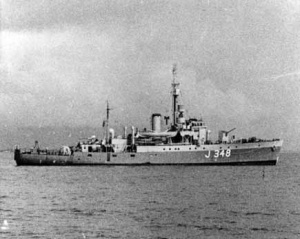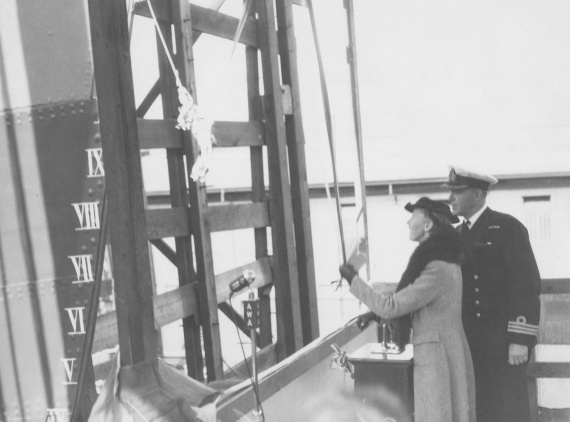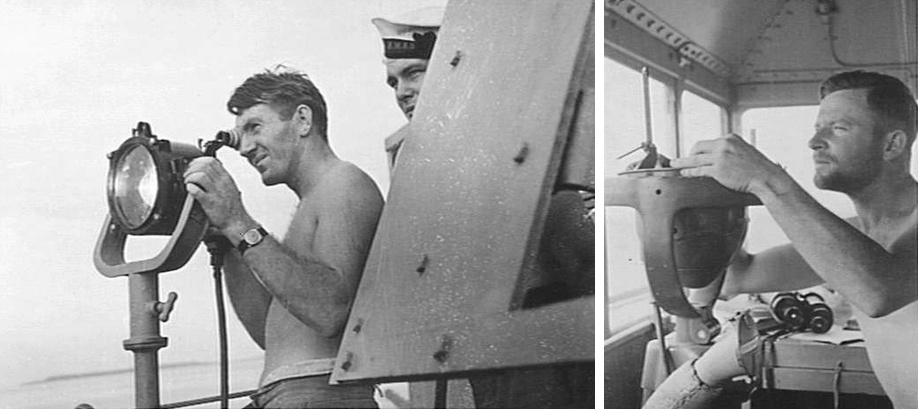HMAS Stawell
| Class |
Bathurst Class |
|---|---|
| Type |
Australian Minesweeper |
| Role | Minesweeping & Convoy Escort |
| Pennant |
J348 |
| Builder |
Melbourne Harbour Trust, Williamstown |
| Laid Down |
18 June 1942 |
| Launched |
3 April 1943 |
| Launched by |
Mrs Dedman, wife of the Minister for War Organisation of Industry |
| Commissioned |
7 August 1943 |
| Decommissioned |
26 March 1946 |
| Fate |
Transferred to the Royal New Zealand Navy in May 1952. In July 1968 she was sold to Pacific Scrap Ltd of Auckland and broken up. |
| Dimensions & Displacement | |
| Displacement | 650 tons |
| Length | 186 feet |
| Beam | 31 feet |
| Draught | 8 feet 6 inches |
| Performance | |
| Speed | 15 knots |
| Complement | |
| Crew | 85 |
| Propulsion | |
| Machinery | Triple expansion, 2 shafts |
| Horsepower | 2000 |
| Armament | |
| Guns |
|
| Other Armament |
|
| Radars | Type 271 radar |
| Awards | |
| Battle Honours | |

HMAS Stawell was one of sixty Australian Minesweepers (commonly known as corvettes) built during World War II in Australian shipyards as part of the Commonwealth Government’s wartime shipbuilding programme. Twenty were built on Admiralty order but manned and commissioned by the Royal Australian Navy. Thirty six (including Stawell) were built for the Royal Australian Navy and four for the Royal Indian Navy.
Stawell was laid down on 18 June 1942 at Williamstown, Victoria and launched on 3 April 1943 by Mrs Dedman, wife of the Minister for War Organisation of Industry. The corvette commissioned at Melbourne on 7 August 1943 under the command of Lieutenant Sidney J Griffith RANR(S).
Following trials in the Melbourne area, the ship was engaged in escorting convoys on the Australian east coast and to and from New Guinea ports.
From commissioning until the end of hostilities on 15 August 1945, a considerable proportion of Stawell’s service was in the New Guinea area, her varied duties including, in addition to escort work, patrolling and assistance to land forces by bombardment.
On 18 December 1943, Stawell, in company with HMA Ships Gympie (I) and Gladstone (I), were escorting a convoy of eight merchant vessels with troops embarked bound for Milne Bay when seven of the eight ships, along with Gladstone, ran aground on Bougainville Reef in the Great Barrier Reef just after 9:30 that evening. Gladstone refloated herself within the hour and the three escorts took up station just off the reef until daybreak. The vessels Colorado, Ambrose Bierce and City of Fortworth had all managed to free themselves by dawn and, with HMA Ships Lithgow and Castlemaine arriving to assist, and her own starboard propeller damaged, Gladstone detached at just after 7:00am to escort the trio back to Cairns.
Stawell, along with Lithgow, Gympie and Castlemaine, began disembarking troops from the stricken vessels at just after 9:00am. All the troops were transferred by 11.30 that morning and the remaining ships were quickly refloated suffering varying degrees of damage.
In April 1944 she rendered assistance, with other ships, to the United States vessel Frederick Billings (operated by the US War Shipping Administration), which had gone aground in Milne Bay.
The following month saw Stawell in action against Japanese forces on Kar Kar Island, north east of Madang, and later escorting convoys between Madang, Manus Island, Humboldt Bay and Langemak. In August 1944 she ended patrol duty to return to Melbourne for a refit.
Stawell was back in the New Guinea area in October 1944 on convoy and minesweeping duties. During July and August 1945 she was at Morotai and Balikpapan. On 3 August 1945, in the Moluccas area, she attacked and sank a Japanese armed barge.
Stawell departed Morotai on 19 August for Subic Bay in the Philippines, arriving on 22 August. On 26 September she sailed for Hong Kong, arriving on 29 September. The ship remained in the Hong Kong area conducting anti-piracy patrols until leaving with other ships of the 21st Minesweeping Flotilla for Morotai on 17 October.
Early in November 1945 Stawell arrived at Brisbane, where she paid off on 26 March 1946, having steamed 75,723 miles.
Stawell was transferred to the Royal New Zealand Navy in May 1952 and commissioned as HMNZS Stawell. In the late 1950s she paid off into Reserve. In July 1968 she was sold to Pacific Scrap Ltd of Auckland and broken up.
Note: This video is hosted on YouTube. Department of Defence users will not be able to view this video on the Defence Protected Network.
This cine film has been placed online as part of the Sea Power Centre - Australia’s ongoing archival digitisation program.
Further Reading
- We Lived With Danger: A history of the Australian Corvette HMAS Stawell (J348), 1943-1945, by Geoff Brooks © 1994.
- The Corvettes: Forgotten Ships of the Royal Australian Navy, by Iris Nesdale - published by the author, October, 1982.
- Corvettes - Little Ships for Big Men, by Frank B Walker - published by Kingfisher Press, NSW, 1996.
- The Australian Centenary History of Defence Volume III, The Royal Australian Navy, edited by David Stevens, Oxford University Press, South Melbourne, Victoria, Australia, 2001.












